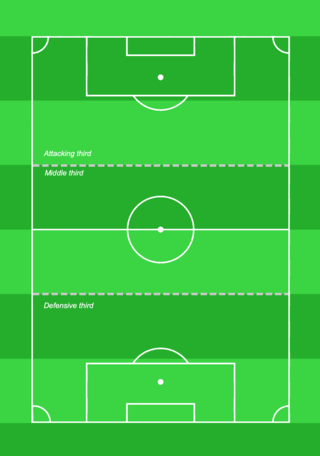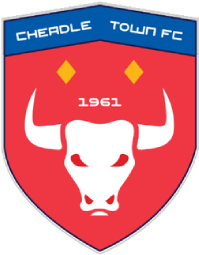
Association football, commonly known as football, or soccer, is a team sport played between two teams of 11 players each, who primarily use their feet to propel a ball around a rectangular field called a pitch. The objective of the game is to score more goals than the opposing team by moving the ball beyond the goal line into a rectangular-framed goal defended by the opposing team. Traditionally, the game has been played over two 45-minute halves, for a total match time of 90 minutes. With an estimated 250 million players active in over 200 countries and territories, it is the world's most popular sport.

A penalty kick is a method of restarting play in association football, in which a player is allowed to take a single shot at the goal while it is defended only by the opposing team's goalkeeper. It is awarded when an offence punishable by a direct free kick is committed by a player in their own penalty area. The shot is taken from the penalty spot, which is 11 m from the goal line and centred between the touch lines.

In baseball, the dugout is a team's bench and is located in foul territory between home plate and either first or third base. There are two dugouts, one for the home team and one for the visiting team. In general, the dugout is occupied by all players not prescribed to be on the field at that particular time, as well as coaches and other personnel authorized by the league. The players' equipment is usually stored in the dugout.

Team tactics as well as individual skills are integral for playing association football. In theory, association football is a very simple game, as illustrated by Kevin Keegan's namely assertion that his tactics for winning a match were to "score more goals than the opposition". Tactical prowess within the sport is nonetheless a craftsmanship of its own, and one of the reasons why managers are paid well on the elite level. Well-organised and ready teams are often seen beating teams with more skillful players on paper. Manuals and books generally cover not only individual skills but tactics as well.
The Laws of the Game are the codified rules of association football. The laws mention the number of players a team should have, the game length, the size of the field and ball, the type and nature of fouls that referees may penalise, the offside law, and many other laws that define the sport. During a match, it is the task of the referee to interpret and enforce the Laws of the Game.

A football pitch is the playing surface for the game of association football. Its dimensions and markings are defined by Law 1 of the Laws of the Game, "The Field of Play". The pitch is typically made of natural turf or artificial turf, although amateur and recreational teams often play on dirt fields. Artificial surfaces are allowed only to be green in colour.

In sports, an ejection is the removal of a participant from a contest due to a violation of the sport's rules. The exact violations that lead to an ejection vary depending upon the sport, but common causes for ejection include unsportsmanlike conduct, violent acts against another participant that are beyond the sport's generally accepted standards for such acts, abuse against officials, violations of the sport's rules that the contest official deems to be egregious, or the use of an illegal substance to better a player's game. Most sports have provisions that allow players to be ejected, and many allow for the ejection of coaches, managers, or other non-playing personnel. In sports that use penalty cards, a red card is often used to signal dismissals. In some sports, another player is permitted to enter the game in place of the player who has been ejected, but in others the team is required to continue the game with a reduced number of players.

In association football, a substitute is a player who is brought on to the pitch during a match in exchange for an existing player. Substitutions are generally made to replace a player who has become tired or injured, or who is performing poorly, or for tactical reasons. A player who has been substituted during a match takes no further part in the game, in games played under the standard International Football Association Board Laws of the Game.

In the sport of association football, fouls and misconduct are acts committed by players which are deemed by the referee to be unfair and are subsequently penalised. An offence may be a foul, misconduct or both depending on the nature of the offence and the circumstances in which it occurs. Fouls and misconduct are addressed in Law 12 of the Laws of the Game. A foul is an unfair act by a player, deemed by the referee to contravene the game's laws, that interferes with the active play of the match. Fouls are punished by the award of a free kick to the opposing team. A list of specific offences that can be fouls are detailed in Law 12 of the Laws of the Game ; these mostly concern unnecessarily aggressive physical play and the offence of handling the ball. An infringement is classified as a foul when it meets all the following conditions:
- It is committed by a player ;
- It occurs on the field of play;
- It occurs while the ball is in play;
- It is committed against an opponent.

The Estadio Cuscatlán is a football stadium located in the city of San Salvador, El Salvador. It was inaugurated in 1976. It can hold 53,400 spectators, making it the Association Football stadium with the largest spectator capacity in Central America and the Caribbean. The stadium has undergone several renovations, including in 1997; 2007; 2008; 2015, with the change of colors alluding to the country's flag ; and the most recent in 2020, with the installation of a new screen 100m² 4K LED and 54 new 1,500-watt metal halide luminaires with a capacity of 1,000 luxes, and an automated irrigation system.

Cheadle Town Football Club are a football club based in Cheadle, Greater Manchester. They were established in 1961 and joined the North West Counties Football League in 1983. They are currently members of the North West Counties League Premier Division. Their home ground is Park Road Stadium.

Solihull Moors Football Club is a professional association football club based in Solihull, England. The club currently competes in the National League, the fifth level of the English football league system, after achieving promotion from the National League North in the 2015–16 season.

In association football, an assistant referee is an official who assists the referee in administering the Laws of the Game during a match. Although assistants are not required under the Laws, at most organised levels of football the match officiating crew consists of the referee and at least two assistant referees. The responsibilities of the various assistant referees are listed in Law 6, "The Other Match Officials". In the current Laws the term "assistant referee" technically refers only to the two officials who generally patrol the touchlines, with the wider range of assistants to the referee given other titles.
Anthony Bates is a former English association football referee who operates in the Football League, and previously served as assistant referee for UEFA in the Euro 96 competition. He also refereed the FA Women's Cup Final in 2007. On average, Bates gave a high 4.0 cards per game in the 1998–99 season, the highest so far in his career.
Donald Cameron Cunningham, known as Donald Colman, was a Scottish football player and coach in the early years of the 20th century, most notably for Aberdeen. His career in senior football did not begin until he was in his late twenties, and he was capped by Scotland at the late age of 33. As a coach, he was renowned partly as the inventor of the dugout, a sunken, sheltered area for note taking, which he introduced at Aberdeen's Pittodrie Stadium, making it the first football stadium to feature this innovation.

Association football was first codified in 1863 in England, although games that involved the kicking of a ball were evident considerably earlier. A large number of football-related terms have since emerged to describe various aspects of the sport and its culture.
On 10 September 1985, the Welsh and Scottish national teams played each other during the qualifying stages of the 1986 FIFA World Cup at Ninian Park, the home of Cardiff City. The game was both teams' final match of the qualifying tournament, and both were still able to gain a place at the finals in Mexico; Wales needed to win the game, while Scotland knew that a draw would be enough.

Comparison of association football (football/soccer) and rugby union is possible because of the games' similarities and shared origins.

Futsal began in the 1930s in South America as a version of association football, taking elements of its parent game into an indoor format so players could still play during inclement weather. Over the years, both sports have developed, creating a situation where the two sports share common traits while also hosting various differences.

The issue of smoking in association football is a historical controversy. Traditionally, football managers would smoke on the touch-line as well as players smoking away from the pitch. However, growing anti-smoking trends have led to a number of restrictions being put in place surrounding them. Smoking is now largely banned from stadiums around the world, but some individual players and managers have continued to smoke.

















